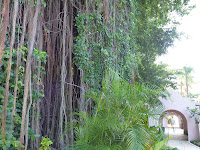The Fairmont Royal Pavilion
was originally built in the 1940’s and was the first hotel to be constructed on
the West Coast of Barbados. Although it has expanded in size over the years,
the overall architecture of the hotel is Mediterranean, the buildings enhanced
by tropical gardens originally designed by the renowned South American
landscape architect Fernando Tabora.
 The sweeping drive of majestic
palms lit from the coast road had always held a fascination for me so I booked
myself in for breakfast and a tour of the gardens with head gardener, Winslow
Greaves, who has spent the last 25 years of his working life tending the plants
around the 11 acre site and knows each plant intimately.
The sweeping drive of majestic
palms lit from the coast road had always held a fascination for me so I booked
myself in for breakfast and a tour of the gardens with head gardener, Winslow
Greaves, who has spent the last 25 years of his working life tending the plants
around the 11 acre site and knows each plant intimately.
 Open air atriums, pathways and
courtyards are all lushly planted with a huge array of plants ranging from
Crotons through to Ixoras and Philodendrons with plenty of treasures in between
- a scented white Gardenia had reached shrub-like proportions in one shady
courtyard and a yellow chalice vine scrambled up and through a trellis in
another more sunny spot.
Open air atriums, pathways and
courtyards are all lushly planted with a huge array of plants ranging from
Crotons through to Ixoras and Philodendrons with plenty of treasures in between
- a scented white Gardenia had reached shrub-like proportions in one shady
courtyard and a yellow chalice vine scrambled up and through a trellis in
another more sunny spot.
 The native bearded fig after
which Barbados was named by the Portuguese explorer Pedro a Campos (meaning ‘the bearded ones’ in Portuguese) towered over
a pathway and a banana was fruiting above an understorey of star jasmine.
The native bearded fig after
which Barbados was named by the Portuguese explorer Pedro a Campos (meaning ‘the bearded ones’ in Portuguese) towered over
a pathway and a banana was fruiting above an understorey of star jasmine.
Bushy Acalypha dripping with its red
tail-like flowers made our own very British summer bedding offerings seem
pathetic in comparison.
Away from the hotel buildings there are more botanical treasures to be found within the grounds –over 50 different varieties of palm to be discovered and one in particular, the silver fan palm, was shown off well by some brilliant textural plantings.
 The gardens were full
interesting plants but, for me, some parts of the grounds were a tad too
neat. I have a personal preference for
plants to spill naturally rather than be clipped into hedge-like
uniformity. In some areas (but not all)
of the gardens, this particular style of maintenance made some parts of the
garden feel a bit clinical, less relaxed and thus detracted from the
atmosphere.
The gardens were full
interesting plants but, for me, some parts of the grounds were a tad too
neat. I have a personal preference for
plants to spill naturally rather than be clipped into hedge-like
uniformity. In some areas (but not all)
of the gardens, this particular style of maintenance made some parts of the
garden feel a bit clinical, less relaxed and thus detracted from the
atmosphere.But onto the gastronomical element of my visit which, in this case, was breakfast. Every variety of fresh fruit, breads and pastries were the continental offering along with a selection of hot dishes and eggs cooked to order. But you could have a bit of everything and eating al fresco with an exceptional sea view was a perfect excuse to linger over as many breakfast courses that it was possible to have and for as long as possible, although 8am to 10am is the norm. Garden tours are every Wednesday from 10am to 11.30am and can assist in working off the calories once overindulgence has taken place.
NOTE: Fernando Tabora was
involved in designing the Parque Del Este in Caracas, Venezuela, and the Aterro
Do Flamengo Park in Rio de Janeiro, Brazil. In 1968, Tabora and his partner,
John Stoddart, received the National Venezuelan Award for Landscape
Architecture. Tabora is still consulted on landscape design at The Fairmont
Royal Pavilion.
You can also book for Sunday
buffet lunch and the special evenings here –the Tuesday night Gala dinner and
the Thursday night West Indian cookout.
Fairmont Royal Pavilion, Porters, St James


















































